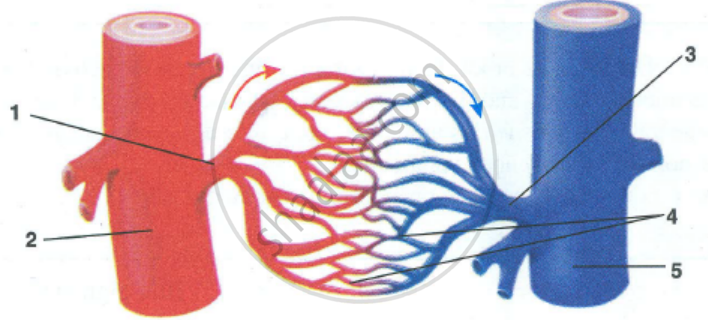Advertisements
Advertisements
Question
Given below is a diagrammatic representation of certain types of blood vessels in human body.

Where can such an arrangement be found as an example - in lungs or in heart walls?
Solution
The types of blood vessels numbered 1 to 5:
- 1 represents Arteriole
- 2 represents Artery
- 3 represents Venule
- 4 represents Capillaries
- 5 represents Vein
Such an arrangement can be found in the Lungs.
APPEARS IN
RELATED QUESTIONS
Write the function of valves present in between atria and ventricles.
Differentiate between the following pair of terms:
Vena cava and aorta.
Fill in the blank.
___________ carry pure blood.
Define the term Veins.
Describe the structural differences between an artery and a vein.
Put a tick mark (✓) against the correct alternative in the following statement.
Blood Capillary is a
Which type of blood flows through pulmonary veins?
Select the INCORRECT statement.
Select the incorrect statements with respect to blood vessels.
- Capillaries are thin-walled having a single layer of ciliated epithelium.
- Arteries are pulsatile and devoid of valves.
- Portal vein starts as capillaries from one organ and ends as capillaries in another organ.
- All arteries carry oxygenated blood whereas all veins carry deoxygenated blood.
- Capillary walls bear fenestrae through which WBCs can move out by diapedesis.
Choose the correct answer from the options given below:
Given alongside are diagrams of a certain category of blood vessels showing the role of a special structure in their walls. Study the figure and answer the questions that follow.
 |
- Name the kind of blood vessels shown in the figure. What are its branches termed as?
- Name the structure shown inside the blood vessels. Write its important role.
- What kind of blood flows through these blood vessels normally? Name the blood vessel which carries blood from the heart to the lungs.
- Name a similar kind of blood vessel which is related to the liver and kidney.
- Draw a neat and labelled diagram of the transverse section of the blood vessel shown above showing the three layers of its wall and lumen.
